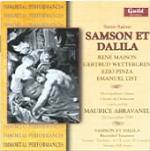This latest in Guild’s “Immortal Performances” series is hardly “immortal”, but it’s certainly worth a listen, and for historical recording fans, a purchase. It documents a live Metropolitan Opera broadcast from December, 1936, complete with Milton Cross’ commentaries, which will hearten nostalgia buffs. The main point of interest is René Maison’s Samson. He debuted at the Met earlier in 1936 and was a company stalwart for the next eight years, replacing Martinelli as the house’s Samson and singing a variety of German and French roles. He has the French style down pat: he delivers his declamatory entrance aria, “Arrêtez, ô mes frères!”, with an appropriate Otello-like ring and executes his Mill Scene with poignant agony.
Another point of interest is Maurice Abravanel’s idiomatic conducting in his Met debut before moving on to Broadway and the Utah Symphony. His vigorous interpretation plays up the drama and relaxes for the lyrical passages. Finally, there’s the luxury casting that has Ezio Pinza as the High Priest, overwhelming the Dalila in their scenes together, and Wagnerian Emanuel List in the bit part of the Old Hebrew.
The main problem with the performance is the Dalila, the sadly overparted Swedish mezzo Gertrud Wettergren. From her picture in the booklet, she fulfills the physical requisites of a believably seductive temptress, but the recorded voice makes her sound like Dalila’s mother, and her light, lyric instrument lacks the reserves to fill out and expand when the music calls for it. So her big arias go for naught; there’s little vocal allure and too much of her singing sounds effortful and quavery.
Guild includes as a filler the heart of the opera, Scene 3 of Act 2, and the Mill Scene, with the Samson of César Vezzani and Marie Duchêne’s Dalila. Recorded several years before the Met performance, this one easily trumps it. So does that of José Luccioni and Hélène Bouvier in the best recorded Samson et Dalila yet, a 1946 version on Naxos. If you must have stereo, there’s Jon Vickers’ unique Samson with Rita Gorr’s Dalila on EMI. Guild’s transfers eschew sound reduction manipulations that reduce musical overtones, so we get unadorned 1936 broadcast sound complete with patches of noise, crackling, and distortion. But this shouldn’t be particularly bothersome to collectors of live historical productions.
































